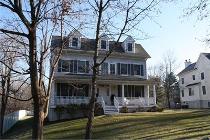Tropical storm Irene blew through Westchester County and much of the northeast, dumped enormous quantities of water and departed leaving mud in some places and elevated water tables virtually everywhere. Even if your home was not subject to overflowing streams or on the downside of a hill, you could have experienced flooding. Unless the invading water was removed immediately and the structure and materials subjected to it dried right away, mold could become a serious problem.
In general there are a number of things that you should know about mold.
There are potential health risks and symptoms associated with mold exposure which most often include allergic reactions, asthma and other respiratory complaints. There is no practical way to eliminate all molds and their mold spore “offspring” in the indoor environment. One can only control the circumstances which foster its growth. Mold can grow anywhere and on virtually any substance so long as moisture is present; everything from wood to paper to fabric and foods.
If you discover mold in your home your only recourse is to clean it up and identify and eliminate the source of moisture. There are environmentally safe fungicides that will kill mold, but the mold and spores must be removed to solve any health issues. Mold can be cleaned off hard surfaces with water and detergent and then dried completely. Unfortunately, absorbent materials such as ceiling tiles, sheetrock and carpets that are moldy must be removed and discarded. It’s not wise to replace carpeting in areas where there is persistent moisture, most basements, kitchens and bathrooms.
Many moisture problems start on the lower level. The first things to check are your gutters and leaders. Be sure that they are free of debris and deflect water from the foundation perimeter. Surrounding soil should slope away from the house. If the gutters are working correctly and basement flooding remains a chronic problem, install a sump pump which will prevent water from penetrating through the concrete flooring. If there is a crawlspace rather than a basement, a plastic membrane should be installed over the dirt to prevent moisture from coming in from the ground. The best solution would include a concrete barrier on top of the plastic. Roofs can leak too causing mold problems. Flashing is the most common problem site.
Reducing indoor humidity to a range of 30-60% will help control mold growth that is not caused by leaks. Simple ways of doing this include venting bathrooms, dryers and other moisture-generating sources to the outside, using air conditioners and de-humidifiers, increasing ventilation and using exhaust fans whenever cooking, dishwashing and cleaning.
Another overlooked source of moisture is condensation. The potential for this problem can be reduced by adding insulation around windows, on piping, in exterior walls, below the roof and attic floor. (Insulation must be installed correctly or the problem can actually be exacerbated.) Increasing circulation thereby raising the temperature of cold surfaces where moisture condenses helps to prevent a climate attractive to mold. Ultimately, fixing the sources of moisture is the only way to stymie mold growth. As verdant as the Northeast can be, it is also a great place to grow mold.



